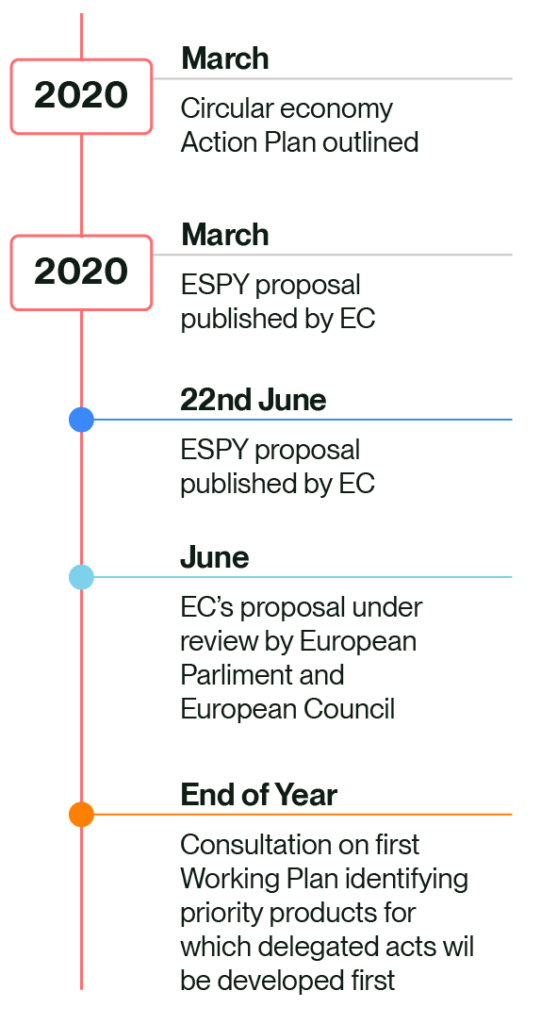Home Regulations Hub ESPR
The EU Ecodesign for Sustainable Products Regulation (ESPR)

Home Regulations Hub ESPR

[This article was updated 19.01.2024]
The proposal for the new Ecodesign for Sustainable Products Regulation (ESPR) has landed, meaning brands all over the world must grapple with the need to understand and then implement a raft of new requirements.
It is a proposed piece of legislation in the European Union (EU) that will set ecodesign requirements for a wide range of products. The ESPR will be a significant piece of legislation that will have a major impact on the way products are designed, manufactured, and marketed in the EU. The regulation is expected to lead to a significant reduction in the environmental impact of products and make the EU more resource efficient.
The ESPR’s proposed product categories for action:
Learn more about the Ecodesign regulation, how it will affect you and what you need to do to comply.
Presented as a proposal by the European Commission on 30th March 2022, the ESPR forms part of the Sustainable Products Initiative (SPI), which includes a range of proposals released in support of the European Green Deal.
Originally announced in March 2020, as part of the package of measures in the Circular Economy Action Plan (one of the main building blocks of the European Green Deal, Europe’s agenda for sustainable growth), the goal of the Sustainable Products Initiative (SPI) is to “make sustainable products the norm in the EU” by increasing their durability, reusability, repairability, recyclability and energy efficiency.
The ESPR is currently working its way through the legislative process and, if adopted by the European Commission, will set out a general framework imposing ecodesign requirements on products intended for sale on EU markets. Any organisation placing goods for sale on the European market, whether or not they are based within Europe, will be required to comply with the requirements of the regulation. Additional delegated acts with specific requirements for a particular product or group of products will follow, with up to 30 new delegated acts anticipated by 2030.
The proposed ESPR, and specifically the delegated acts that will follow it, will have a significant impact on the way in which products are designed in the future.
The use of a variety of products is part of everyday life for all of us. Although consumers are now paying more attention to how they recycle products, there is less focus on the wide-ranging and significant negative impacts associated with the production, consumption, and eventual disposal of such products. Negative environmental impacts arise across the lifecycle of a product, from the initial extraction of raw materials, through energy-intensive manufacturing, global distribution, and the generation of waste at the end of life.
By addressing design, which determines up to 80% of the environmental impact of a product across its lifecycle, the proposed ESPR forms the bedrock of the SPI.
The ESPR’s proposed performance requirements for products:
The ESPR expands the scope of its predecessor, the current and successful EcoDesign Directive 2009/125, by including products of “the broadest possible range”, rather than just energy-related products. It also covers component parts and intermediary products (food, feed and medicinal products will however be exempt).
The proposed ESPR approach is three-pronged:
The ESPR’s proposed information requirements require that companies generate and maintain a product Digital Product Passport (DPP). The DPP may include the following information:
The ESPR’s proposed disclosure requirements also states that any economic operator that discards unsold consumer products shall disclose on a freely accessible website the number of unsold consumer products discard per year, the reason for discarding products, and the number of discard products delivered to remanufacturing, recycling, and preparation for reuse.

The ESPR details the general framework imposing ecodesign requirements on products intended for sale on EU markets. However, it is the additional delegated acts that will contain specific requirements for a particular product or group of products. Although such delegated acts will not come immediately (and based on the existing speed of development under the Ecodesign Directive the timeline could be quite lengthy), the Commission already consulted on its first Working Plan earlier this year. This plan will identify a list of priority products for which delegated acts will be adopted. 30 new delegated acts are expected to be created by 2030.
Of highest importance will be those products that can positively contribute to the EU’s climate, environmental and energy objectives. The initial list of identified products for the first working plan includes textiles, furniture, mattresses, tyres, detergents, paints, lubricants.
Once any product specific delegated acts are in place, the performance and product information requirements for obligated products can be extensive. Performance requirements could include measures related to durability, reliability, reusability, upgradability, repairability, maintenance and refurbishment, the presence of substances of concern, energy use or energy efficiency, resource use or resource efficiency, recycled content, the possibility of remanufacturing and recycling, the possibility of the recovery of materials, the environmental impacts including carbon and environmental footprint; and expected generation of waste materials.
To comply with the information requirements, relevant products placed on the market will need to be supplied with detailed information giving the consumer visibility under each of the performance requirement topic areas. This information can be physically displayed on the product or its packaging or be standalone e.g., through a website. Given the volume of information required it is probable that product passports might be the preferred method for providing this information.
The degree to which the proposed regulations could impact individual businesses and the products they manufacture will vary. For those organisations whose products are captured under the current Ecodesign Directive, preparations may take a similar format.
It is clear that we need to rethink how we produce and consume goods if we are to move away from the traditional linear economy of take-make-dispose and implement a truly circular economy in the Decisive Decade. Part of this journey will be streamlining the regulatory framework, so it is fit for a sustainable future.
While the ESPR will move us a step closer to making sustainable products the norm at a European level, the reality of what this will mean in practice will be determined by the subsequent delegated acts and their enforcement. It is, however, clear that the ESPR will have a significant impact on the way products are designed and managed in the future. To ensure compliance with the requirements in the regulations, businesses should consider how they start preparing for and embracing the changes.
Anthesis can help you:
We are the world’s leading purpose driven, digitally enabled, science-based activator. And always welcome inquiries and partnerships to drive positive change together.